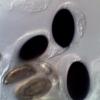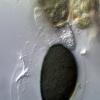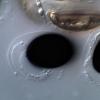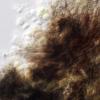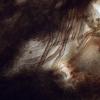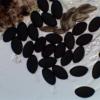
23-11-2025 11:16
Bohan JiaHi, I found small discs growing on dead stem of

21-11-2025 10:56
 Christopher Engelhardt
Christopher Engelhardt
Very small (~0,5 mm) white ascos, found yesterday

21-11-2025 11:52
Jean-Luc RangerBonjour à tous, on voit toujours 2 espèces areni

14-11-2025 16:26
 Marian Jagers
Marian Jagers
Hello everyone, On dead wood of Cytisus scoparius

17-11-2025 21:46
Philippe PELLICIERBonjour,Récolté sur bois pourrissant de feuillu
Podospora excentrica
Chris Yeates,
08-10-2021 17:19

Bonjour tous
A recent collection of dung from mountain hare Lepus timidus was seen to have a perithecium of this species even before incubation commenced. Examination with Nomarski DIC gave an opportunity to look for the gelatinous appendages normally invisible without indian ink (which was later used to double-check the identification). The perithecium only contained asci at various stages of immaturity, some old collapsed spores and numerous fully mature ones no longer in their asci.
So these images show the latter, as well as a couple of submature spores which show the asymmetry well. I thought fellow copromycologists might be interested. As you can see with DIC the apical appendage shows quite well as a sort of gel sheath, with a definite margin - hard to see in indian ink mounts which are of necessity more diffuse. I was not able to distinguish the basal appendages with this technique, perhaps because the spores were not fresh out of the asci.
Another feature I noticed - though forgot to photograph - was that the pedicels were consistently of a distinctive shape. Unlike the simply rounded club-like pedicels one generally sees in Podospora these had a rather "pinched out" apex, a little like a teat.
Amitiés, Chris
Michel Delpont,
08-10-2021 18:45

Re : Podospora excentrica
Bonsoir Chris!
Indeed the shape of the spores and their pedicels of your harvest make one think of exentrica. Have you been able to observe the hairs at the top of the perithecium and measure the size of the spores?
Amitiés.
Michel.
Chris Yeates,
08-10-2021 19:26
Michel Delpont,
08-10-2021 20:15

Re : Podospora excentrica
The size of the spores is in the upper range (especially the width), the hairs as well as the slightly exentricated germ pore lead to P.exentrica.
Michel.
Chris Yeates,
08-10-2021 20:36

Re : Podospora excentrica
Thanks
Lundqvist in Nordic Sordariaceae gives much wider spore measurements (18-24µm). I've noticed on other occasions that his measurements can differ from other authors. Doveri gives a Qe of 1.89, mine was 1.9; so yes I'm happy with the identification.
Chris
Norbert Heine,
08-10-2021 23:12

Re : Podospora excentrica
Great Found, Chris!
In my opinion this is a rare species. You should compare with this nice documentation.
Norbert


